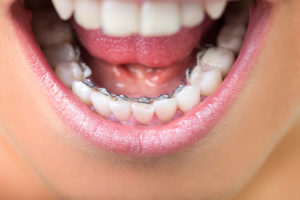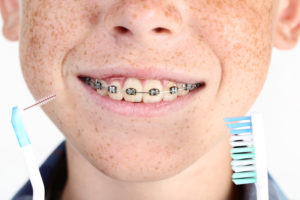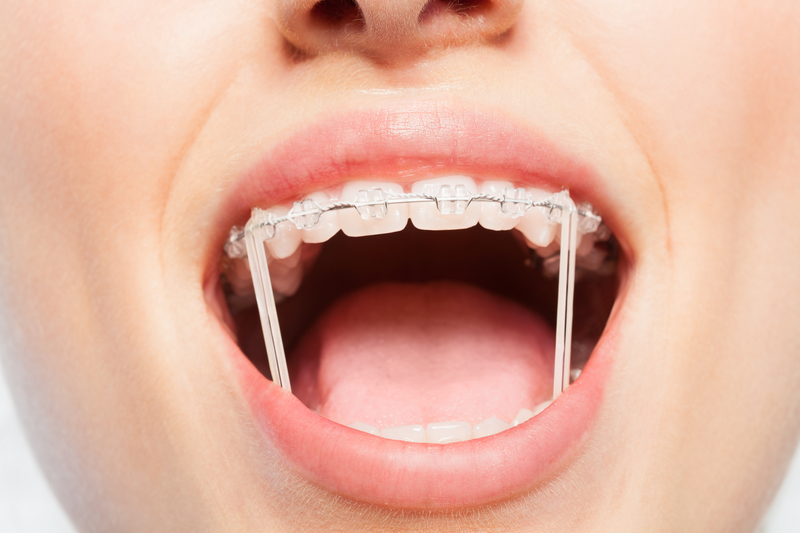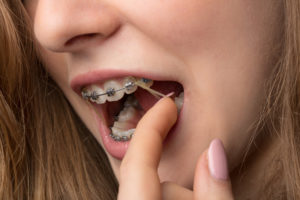Perks of Lingual Braces

As modern technology has improved the tools and appliances that are now used in orthodontic offices, there are more options than ever for patients to get straighter teeth without the look of traditional metal braces. Lingual braces are an ideal option for patients who want orthodontic care but in the most discreet way possible. By using a hidden apparatus on the tongue-side of your teeth, you can get straight, beautiful teeth without sacrificing your confidence. Find out what other perks lingual braces have and what treatment looks like with this guide!
What Are Lingual Braces?
Braces have come a long way since they were first invented, and patients have more options than ever to get the straight teeth they want without sacrificing their confidence. Traditionally, metal braces were the most common type of orthodontic appliance used but were bulky and aesthetically not very pleasing. With the modern technology that has been developed during the last few decades, one type of braces in particular has become more and more common. Lingual braces are an alternative to traditional metal braces and provide utmost discretion as they are almost completely hidden. Unlike traditional braces whose brackets are attached to the front of the teeth, lingual braces are attached to the back side (tongue-side) of teeth, making them practically hidden from view. Fortunately, lingual braces can provide the same results as traditional braces but in a manner that is nearly undetectable. These braces are particularly helpful for patients, especially teenagers, who think braces are unattractive or distracting. Now, more than ever, patients can receive the orthodontic treatment they need without putting it off for aesthetic reasons.
How Lingual Braces Differ From Other Options
While the obvious advantage of choosing lingual braces over other orthodontic appliances deals with the invisibility of the braces themselves, there are other reasons why lingual braces might be the best option for you. Since their invention in the 1980s, lingual braces have slowly gained recognition as a viable option for orthodontic treatment. In fact, very few dentists even offer this technique because special training is needed to perform it. You will still need X-rays, molds and impressions of your teeth to begin treatment, just like you would when getting any other orthodontic treatment. The process is relatively easy to install them, as the brackets are glued to the lingual side of the teeth with a wire and elastics (if needed) to help move the teeth into position. Lingual braces are always on during treatment, so they are constantly shifting your teeth into the correct position without you or others noticing. A similar treatment to lingual braces is called Invisalign, which uses a removable aligner to straighten teeth. Invisalign is a popular option because the aligner is clear and removable so most people don’t notice it’s there, but not everyone is eligible for Invisalign. While Invisalign is a great option, lingual braces tend to be more helpful for patients with specific concerns. Athletes benefit greatly from lingual braces as it helps prevent mouth injuries since the brackets aren’t on the front of the teeth. Musicians, like those who play a wind instrument (flute, trumpet, clarinet, etc.), are also common wearers of lingual braces as they tend to not get in the way as much when playing. Lastly, those patients who don’t qualify for Invisalign typically choose lingual braces as it is the second most discreet option available. Depending on your needs and your orthodontist’s recommendation, you can choose which option you would like to get the beautiful teeth that you want, in the way that you want.
How To Begin Treatment
As mentioned previously, you must be eligible for certain types of orthodontic treatment to receive them. If you are interested in lingual braces, you will first need to visit with your orthodontist to have a consultation and evaluation to determine whether lingual braces are your best option. If you are a candidate, you will have impressions taken of your teeth which will be sent to a lab to create your custom-made brackets and wires. Afterwards, the brackets and wires will be bonded to your teeth to begin treatment. It is important to note that while lingual braces are a great way to keep your treatment unnoticed by others, the braces themselves are more difficult to clean since you can’t see them. For this reason, it is extremely important to clean your teeth thoroughly each day because it will be easier for food to get stuck and bacteria to grow in areas that are hard to see or reach. Another reason why it is important to consult with your orthodontist before choosing lingual braces is the price. Traditional braces typically range from $3,000-7,000, but lingual braces can be anywhere from $8,000-10,000. For patients who are on a budget, this is something to consider as you are in the decision-making process. Check with your dental insurance to see how much they can cover for orthodontic treatment. While many plans don’t offer coverage for adults over 18, many do partially cover children under 18. How much coverage will depend on your provider, so make sure to contact your insurance company for figures and amounts before you or your child begins treatment.
Get Started Today
At Belmar Orthodontics, our team is certified and trained for installing lingual braces. We are ready to help you and your family get the smile you deserve in a way that is most comfortable for you. For a consultation about lingual braces or more information about orthodontic treatment options, call our office at (303) 225-9016. Your journey to a healthier smile starts today, so call now!
Rubber Bands and Braces

Why use rubber bands with braces? Some people have them, and some people don’t need to use them at all. Along with brackets, archwires, and ligatures, rubber bands are just another part of braces. Rubber bands are extremely helpful as they help move the teeth and jaw into proper alignment. They are connected to the actual bracket and help improve your bite. If your jaw is misaligned, read on to discover how rubber bands might be the option to straighten your teeth and jaw at the same time!
Parts of Braces
Modern technology has changed the lives, and smiles, of millions of patients worldwide who have used or currently use braces. Nowadays, braces can be as inconspicuous as we want, with some brackets being attached to the backs of teeth, rather than the front, for a more aesthetic appeal. With the invention of a variety of orthodontic appliances, such as lingual braces, Invisalign, clear braces, and traditional, the patient can decide what braces fits their oral health goals the best. Along with the many types of braces we learn about, there are also other parts of braces that we aren’t as familiar with, such as “bracket,” “archwire,” “springs,” and “ligatures.” We have heard of the different components of braces, but what does an archwire do? How do springs help adjust our teeth? Depending on your needs, your orthodontist will install any of these appliances to help you get the best smile in the shortest amount of time possible.
Brackets are the square part of the braces that are directly attached to the tooth, usually through a cement that bonds it to each individual tooth. They are usually made of steel or clear ceramic, and they guide the archwire into the appropriate placement. The archwire is held by brackets and is designed to guide the movement of the teeth during treatment. They are normally made from stainless steel, but also can be made with titanium. Springs go between brackets and around the archwire and are also made of stainless steel or titanium. They function as a force that opens or closes a space between teeth. The archwire and the bracket are connected through ligatures, which are the little rubber bands that wrap around each bracket to hold the archwire in place. For adolescents, these are usually the best part about braces because they come in a variety of colors that kids can choose from, and are changed after each orthodontic visit whenever the archwire is tightened. Although ligatures are rubber bands, they are not the same thing as interarch rubber bands, which have a major impact on jaw and bite alignment.
Rubber Bands
Interarch rubber bands, commonly known as “rubber bands” or “elastics,” ensure that your child’s teeth are lining up properly. They adjust bite and jaw position, such as an overbite or underbite, and are connected to the bracket with hooks. They create a force to move the teeth in a particular direction, specifically closer together. The top and bottom tooth bracket are connected through these bands, which adjusts the position of the teeth in the mouth and the position of the jaw. These rubber bands are removed during meals as well as while cleaning your teeth and brackets. Usually, they are replaced daily because of the wear they endure and their likelihood of breaking if used for too long. When worn to adjust a misaligned bite, interarch rubber bands are typically worn at all times, except for when eating or cleaning your teeth. If the treatment is only minor, you might only have to wear the bands at night. The consistent tension on the teeth and jaw is what makes these bands effective. If a patient doesn’t wear their bands in the prescribed manner, whether it be the length of time is too short or you’re wearing more bands than normal, this can lengthen treatment time and move your teeth in an unintended way. Not every patient will have to use interarch rubber bands, but if your orthodontic prescribes you to wear them, make sure that you follow his or her directions exactly and take good care of your bands.
Do’s and Don’ts of Braces
While braces have revolutionized the dental and orthodontic professions, there are some rules that a patient needs to follow to protect and get the most use out of their orthodontic appliances. Always make sure to keep your teeth clean when wearing braces. Brushing and flossing under the archwire and between the brackets is essential to remove plaque, which can easily build up on your teeth with braces. To make sure that your teeth are being cleaned entirely, replace your toothbrush every three months or as soon as the bristles are frayed. Go to all of your orthodontic appointments so that they can adjust your archwire and monitor your teeth’s movement. If you delay your adjustments, your treatment time can be increased, which can be expensive.
Even though braces are strong, you can still break a bracket or an archwire with the things that you eat. Avoid foods that can get stuck in your teeth or your braces, such as nuts, popcorn, hard candy, ice, and sticky foods like chewing gum or caramel. Try not to eat as much sugary foods as it can lead to tooth decay around the brackets, which can permanently damage your teeth. Especially for active teenagers and adults, use a mouthguard during physical activity or when playing a sport to protect your mouth and jaw from getting hurt. Following this list of do’s and don’ts will increase the likelihood of having a positive and shorter experience with braces.
Getting The Smile You Deserve
For other tips and suggestions about orthodontic appliances and which one is best for you, call Belmar Orthodontics at (303) 225-9016 for a comprehensive exam. With our team of qualified and dedicated individuals, we will provide you or your child with the best orthodontic care for a great price. Call now to learn more!
How Important Is it to Wear Your Orthodontic Rubber Bands?

Wearing rubber bands is a critical part of your orthodontic treatment. We ask you to wear them 24 hours a day because they are that critical to the process of straightening your teeth. Knowing why your orthodontic rubber bands are important will help you wear them more. Consider the following reasons you need to wear your bands the next time you are tempted to put them aside.
Types of Braces
We offer several different types of braces at our office. Patients wear orthodontic rubber bands when they have traditional metal braces and ceramic braces. When you think of braces, you probably think of metal braces. These are the ones with square brackets on the front of each tooth and a wire that goes through the brackets on top and bottom. Metal braces are the most economical choice when choosing orthodontic care.
A close cousin to metal braces are clear, ceramic braces. These braces look and act like metal braces, except they are white. They have a white color to them because they are made out of ceramic material, which blends into the natural whiteness of your teeth. This is why they are known as “clear braces”. Ceramic material helps decrease demineralization that can happen when patients wear braces and don’t practice good oral hygiene habits. Both types of braces (metal and ceramic) use orthodontic rubber bands at times to move the teeth in a particular direction.

Parts of Braces
Each part of your braces is important when it comes to straightening your teeth in the best way possible in the quickest way possible. Your treatment would be lacking if you were missing any part of your braces, including orthodontic rubber bands.
- Bands – A band is a thin ring fitted to a back molar and cemented to the molar. This is usually made of stainless steel and secures other orthodontic attachments such as hooks, brackets or tubes.
- Brackets – A bracket can be bonded to the tooth with cement or it can be attached to a band. Brackets are usually made of stainless steel or clear ceramic material. They guide and support the archwire into its proper placement.
- Archwire – The archwire guides the shifting of the teeth during orthodontic treatment. Orthodontic attachments (such as the brackets) hold these wires and are made from stainless steel. Some archwires are made of titanium instead of stainless steel.
- Elastic Ties – Available in a variety of colors, elastic ties are small rubber bands that go over the brackets in order to hold the archwire in place.
- Springs – We open or close a space between teeth using the force of a small spring. These springs go between brackets and around the archwire, and are made of stainless steel or titanium.
- Orthodontic Rubber Bands
Orthodontic Rubber Bands
There are several different types of bands for braces. There are orthodontic rubber bands and there are ligatures. Ligatures are the small rubber bands that wrap around the brackets and hold the archwire in place. You will see these bands on children in a variety of colors. We switch out ligatures at every orthodontic appointment and children can mix and match the colors. They go around the brackets and protect the teeth and gums from sharp metal points and are changed when the wire is tightened or the braces are adjusted. These orthodontic rubber bands (the ligatures) are very small, as the brackets are small.
The other type of orthodontic rubber bands adjust your bite and jaw position. These will be slightly bigger orthodontic rubber bands. On your brackets, you have small hooks where these rubber bands attach. Often, you will loop a rubber band around a hook on a bracket on the lower jaw and hook it around another bracket on the upper jaw. Some patients will need several orthodontic rubber bands at a time and others will only need one. These rubber bands will adjust the position of the jaw quicker between visits.

Child Orthodontics
You will commonly see orthodontic rubber bands with child orthodontics. This is orthodontics for children under the age of 10 that need braces to correct bite and alignment issues. Orthodontic rubber bands are critical for making those changes possible. Your child should first see the orthodontist around age 7 or 8. This is a time where we can check that the bite lines up properly and that the adult teeth will come in correctly. If there is a bite or alignment problem, we give your child metal or clear braces to correct that problem. Your child will use orthodontic rubber bands throughout their treatment to provide sufficient force to bring the bite into a straight position.
Although small, orthodontic rubber bands are critical for moving the teeth. With orthodontic care, the teeth shift slowly over time. If you skip wearing these bands, your time with braces will be longer and you won’t be correcting bite and alignment problems. This is why we ask our patients to wear their orthodontic rubber bands 24 hours a day. Each part of your braces is important for creating that beautiful, straight smile you’ve always wanted. To learn more about orthodontic rubber bands or other parts of your braces, call Belmar Orthodontics today at (303) 225-9016!
Parts of Braces and Their Importance
What role does each part of braces play? The brackets, bands, wires and even our oral health guidelines all play a vital role to the health of your teeth and the success of your teeth straightening. Braces have been perfected over the years to provide you various options for teeth straightening through traditional metal braces, lingual braces, ceramic clear braces, Invisalign and more. These options weren’t available in years past, and each option has been perfected to provide you quick and efficient teeth straightening. Find out why each part of braces is important and what role each piece plays when it comes to your oral health.
Parts of Braces
Traditional metal braces have been around for decades. We still offer these braces because frankly, they work so well. Metal braces are also the most popular orthodontic option because they work to straighten your teeth the quickest and are the most cost-effective orthodontic option you can find. The metal we use is strong and sturdy. Metal braces are made from stainless steel, but can also be used in combination with titanium. There are three main parts of braces: the brackets, the wire, and the ligature elastics that go around the brackets:
- Brackets – These are the small metal pieces that are bonded to each tooth center using special glue. This glue ensures that the brackets stick to your teeth. The glue is gentle enough that it can be removed once your time with braces has finished. Brackets are made of stainless steel but also can be made white (tooth colored) or clear. These brackets hold the archwire for the teeth.
- Wire – This wire is actually known as the “archwire”. It is the metal wire that connects all of the brackets together in your mouth. You will have one archwire that is along the upper teeth and one that is along the lower teeth. This wire curves around the teeth and puts pressure on the teeth so that they come into proper alignment in the mouth. This is the main player that works to move your teeth in the right direction.
- Ligature Elastics – These are the rubber bands that attach the archwire to the brackets on each tooth. Without these ligature elastics, the archwire would not be sturdy and couldn’t do its job.
Additional Parts of Braces
There are more than just these three parts of braces.
- Headgear – This is an external appliance used in orthodontic care to help realign the face and jaw during your time with braces. There is retraction headgear and protraction headgear. Retraction headgear is an appliance used to retract the upper jaw. Protraction headgear moves the upper jaw forward and into proper alignment with the lower jaw. Headgear will consists of a single strap that fits around your neck and attaches to the front of your teeth. There is a second type of headgear that attaches to your braces, but the headgear has straps that fit over your head and neck. Not all patients will receive headgear unless it is really needed.
- Springs – Many braces have springs to help push and pull the teeth in the right direction. These springs generally attach to the arch wires and are located between the brackets of each tooth. The purpose of the springs are to open up or close up spaces between the teeth as they shift.
- Elastic Rubber Bands – Some patients need the additional shifting power of rubber bands to help the teeth move into place on schedule. These bands are attached to the brackets and will go from a lower tooth bracket to an upper tooth bracket. You will receive these rubber bands at your checkup and instruction for attaching your elastic bands at home until your next checkup.
Different Types of Braces
There are more than types of braces than just traditional metal ones. At Belmar Orthodontics we offer the following additional braces options:
- Incognito Lingual Braces – These braces quite literally go “incognito” as they are hidden inside your mouth. You will receive the same type of treatment as traditional metal braces. However, lingual braces are a hidden treatment apparatus on the tongue-side of your teeth. The brackets and metal are attached here and straighten your teeth without anyone else knowing.
- Invisalign – Invisalign is one of the stealthiest forms of teeth straightening. It is a series of transparent aligners customized to your teeth. You will change these aligners every 1-2 weeks until your smile is straight. They are easy to clean, easy to remove for eating and sports, and are virtually invisible in the mouth.
- Clear Ceramic Braces – Instead of metal, these braces are made from strong ceramic. They appear very similar to metal braces but are colored to match the shade of your teeth so they blend into the mouth. Even the archwires can be made white.
- Retainers – You will receive a retainer after your orthodontic braces treatment has been completed. Wearing your customized retainer is vital to maintaining a straight smile, as the teeth can quickly shift out of place. The first month is the most crucial as this is the time when your teeth will shift the most if a retainer isn’t worn.
Your Free Consultation
Keeping the parts of braces clean will greatly enhance your experience, so following our guidelines will help you find success with your orthodontic care. Proper braces appliances and all their parts will ensure that your teeth shift into perfect alignment in the least amount of time. If you would like to learn more about braces or need to schedule your appointment, call our Belmar Orthodontics office today at (303) 225-9016!
How Orthodontic Elastic Bands Work
Orthodontic elastic bands usually enter the treatment process after patients have been wearing their braces for 4-6 months. Orthodontic elastic bands are a necessary part of the treatment process for some patients because they provide the connective forces needed to move your jaws and teeth into proper alignment. They can’t do their job if you don’t wear them so make sure if you are instructed to use orthodontic elastic bands during treatment that you commit to wearing them. Not wearing them will delay your treatment, prolonging your stay in braces. Learn more about how these little bands do big work for your smile!
The Differences Between Orthodontic Elastic Bands
When your dentist refers to your orthodontic elastics, he could be talking about two different kinds of orthodontic elastics. Ligatures are the rubber elastics that go around your brackets that help the archwire stay in place on your brackets. These ligatures come in all kinds of colors that you can choose to compliment your smile during treatment. Ligatures work to push or pull teeth in the directions they need to go during treatment. Rubber Bands are a larger form of elastic that are employed to apply pressure to the jaw to help achieve proper alignment of your bite. Rubber bands can be inserted in several different configurations to meet the connective force requirements you need. The most common configuration is the inter-arch, or top-to-bottom, configuration. Rubber bands also come in a variety of colors to spice up your smile!
How Orthodontic Elastic Bands Work
Orthodontic elastic bands pull your jaw forward or backward depending on what movement you need to achieve proper alignment. Your upper teeth and lower teeth should line up and fit together comfortably when you bite down. Rubber bands accelerate the moving/straightening process and are an essential part of orthodontic treatment. If you want to get out of your braces on time (or possibly earlier) wear your orthodontic elastic bands the prescribed amount of time–not more, not less. Typically, elastic bands will need to be worn a minimum of 10-12 hours, but for some patients, they need to be worn 24-hours and only removed for eating and cleaning/caring for your braces and teeth.
Wear Elastic Bands Exactly How You Have Been Instructed
Some patients get overly excited about the power of rubber bands and mistakenly think that by doubling up on their bands they can move their teeth more quickly and shorten treatment times. Too much force, too quickly can damage tooth roots and actually stretch-out the amount of time it takes to move your teeth. Wear your orthodontic elastic bands how you are instructed and you will move along without any problems.
What to Expect with Orthodontic Elastic Bands
Choosing the colors of your elastic bands is an exciting part of the treatment process. Reaching a point where you are ready to use elastic bands also means you have arrived at one of your important treatment milestones. Orthodontic elastic bands get you that much closer to achieving your healthy smile rewards! As with anything new, it is common to have some anxiety at incorporating a new skill/habit into your orthodontic treatment. Before you know it, you will be a pro at using them and won’t even really notice that they are there working for you. Soreness of your jaws, mouth and teeth is normal for the first few days after adding orthodontic elastic bands to your treatment routine. Stick to it, the discomfort will go away after your mouth adjusts to this new tool.
Contact Belmar Orthodontics Lakewood
Orthodontic elastic bands are an important part of your orthodontic treatment. They are an essential tool for moving your teeth and jaw into the proper alignment. When it comes time for you to start using them, we will make sure you understand how to use them and how often to use them. Our office is committed to helping you enjoy your time with braces and is available to answer questions at any time. Please contact our office today if you have questions about your current (or future) orthodontic treatment. We are happy to answer your questions, and we can help you schedule a one-on-one consultation with Dr. Hardy to discuss your unique orthodontic needs and goals.


